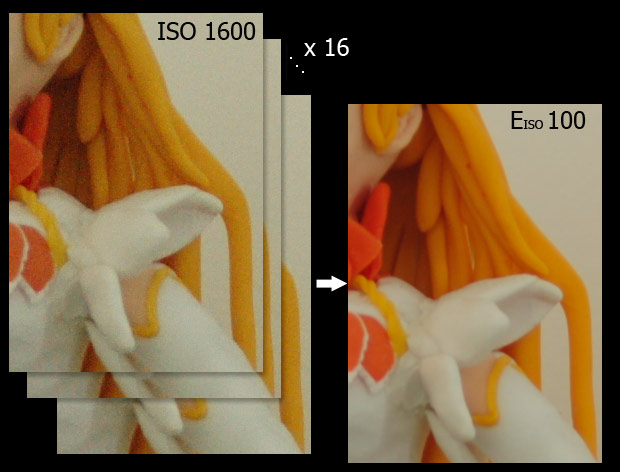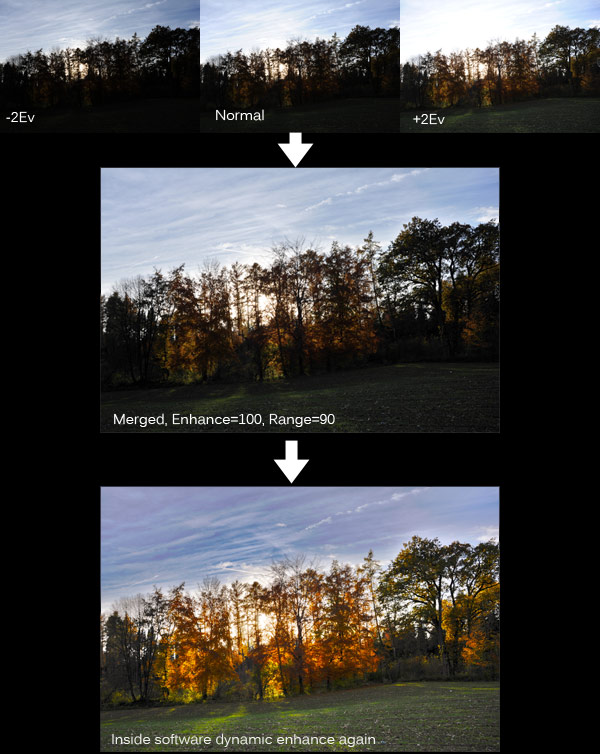The multiple shoot merging tool provides 3 tools to do special things, based on a series of photos taken in the same time and space.
Noise reduction by merging
High ISO noise is always a problem for photographers. Sometimes, high ISO is required when shooting an object in a dark environment where using a flash is not allowed. If the object is still, and you don't have a tripod in hand, you can use this function instead.
First, set your camera in high ISO speed which is enough to get a fast shutter speed that avoids shaking of the hand. Then, set it to the continuous shooting mode. If the ISO value reaches the maximal value while the shutter speed is not short enough you can set Ev to a negative value or use manual mode to make sure the shutter speed is fast enough for handhold. The underexposure problem can be fixed easily later in the program .
You may be wondering if there will be shifting between each photo because of the hand-holding, how will the program avoid this problem? The trick is the program will align each photo automatically before they are merged.
There is an equation with which you can estimation the final quality in output E(iso) = (I(iso)/N) Where E(iso) is the equal quality ISO in merged photos, I(iso) is the ISO value of the input photos. N is the number of input photos. Here is an example: inputting photos are taken in ISO 1600, 16 photos, the estimated output quality should be 1600/16 = ISO 100.

HDR merging
To get a photo with high dynamic range, you can merge 3 photos with bracketing exposure. In this function, the program can align the photos as the noise reduction merges do, but to get a better result, the tripod is recommended.
The parameters 'Shadow', 'Midtone', 'Highlight' control the percentage to merge for each of the photos. Parameter 'Enhance' tries to give a wider dynamic range depending on local brightness. A high enhanced value brings a higher dynamic range, while looking a little unrealistic. 'Radius' parameter sets the size of the gradient area to make it look smoothly changing without the ring artifacts.
If just merging 3 photos is not enough to get a great result you may use the 'Enhance dynamic range' function ( in editor-enhancement menu ) again to get more. Check the following sample:

3D Stereo image (MPO format) maker
This merging function creates a stereo image from 2 inputs, left and right, in MPO format which can be shown on a 3D device.
How to get a pair of images from a normal camera? Firstly, you cannot shoot an object which moves very fast. If you plan to take a 3D portrait picture, tell the people in view-finder to hold their position for a while. During that time you should complete the following movements:
Place your left-eye on the view-finder to take the first photo for the left. Smoothly move the camera to the right about 5-10 cm (2-4 inches) to take another photo for the right. You can't rotate the camera during this movement.
Now you get 2 photos for the left and right eye. Select 2 photos in the album and run 3D stereo image maker. You will see a preview of the 3D image in red-blue format and if you have a red-blue glass, you can preview it. But this is not the final result because those 2 images are not aligned.
Click on the focus centre, for example, the face to align the 2 photos. The alignment point is the focusing point in depth. The rest of the photo, depending on their depth, will keep small misalignments. See the following figure:

To view a MPO photo, you need a 3D device like a 3D TV.

